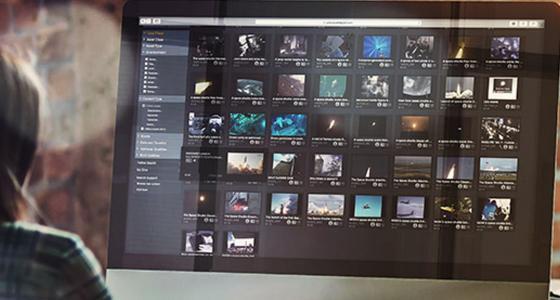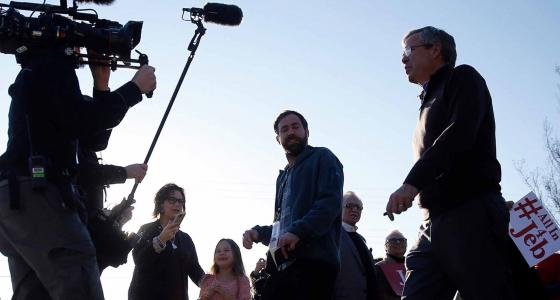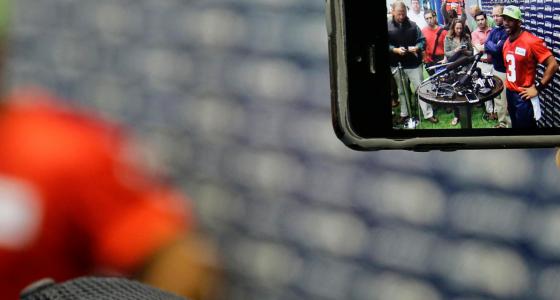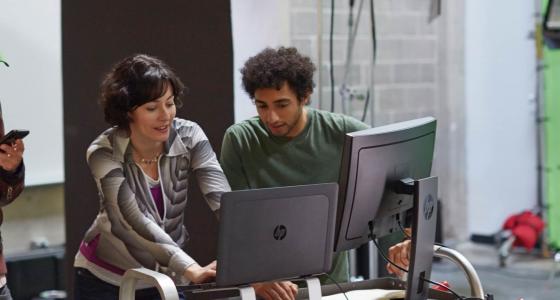When
we think about the future of television, we often have something
science fiction in mind, something fifty years down the road, something
which shows a marked and radical departure from the television
experience we are familiar with today.
But what if I were to say that the future of television isn’t so
different from what we have today? What if I were to say that it’s not
about VR headsets and holograms but more about the way we interact with
video? You might think I’m not creative enough or thinking out of the
box enough. On the contrary, I’d argue that the components of
television’s future are already in play today and, if we look hard
enough, we can see the future of television right now.
The Move to IP
At the heart of this evolution of the television experience is a
fundamental movement by network operators to shift delivery of video
content from QAM (which stands for quadrature amplitude modulation, the
format by which digital cable channels are encoded and transmitted via
cable television providers) to IP. The reasoning is simple—it’s
monumentally cheaper. But there’s more to it than just cost savings. By
shifting to IP, network operators (like your cable company) can enable
the delivery of content to a host of different devices. Smartphones.
Tablets. Computers. Rokus. And that’s important because it’s what their
subscribers are clamoring for. Failing to provide them anytime, anywhere
access means consumers will go elsewhere for their content which has
long-reaching implications for bottom line revenue. But it also signals
something else; a different way to look at video. It’s becoming less of a
“signal” than it is a stream of data that can be manipulated, moved
around, and ultimately shaped to meet individual needs and experiences.
It’s All About Data
Right now, many content owners and distributors still see video as
discrete assets. They see a video as an immutable object, like a book,
housed in a library ready for viewing. But that’s not the future. In the
future, video is just a form of data, a stream of 1s and 0s that can be
manipulated to fit the context into which it is being delivered—the
device, the location, or the individual user. The best example of this
today is Amazon. The retail and streaming giant doesn’t see video as an
object, but rather, a part of a bigger data pool that provides them
details about the user; details they can use to customize the video and
commerce experience. What happens when you watch a video through Amazon
Prime? Recommended products change. Ads change. The amazon.com
experience shifts to reflect the user’s taste in movies. The video
itself is just another piece of data in a larger pie.
When Video Becomes Just Data
As video begins to be treated more like data, it opens the door to
integration and interaction. Whether it’s clicking on an object in a
video to get more information (and ultimately save for later or purchase
directly) or having social experiences (just look at the NFL and
Twitter; that’s only possible when video is treated as just another form
of data), the consumer engagement expands monumentally, enabling new
viewing behaviors and experiences. When the video is treated as a
signal, joined at the hip to the delivery method, it’s much harder to
implement interaction; it’s much harder to shape the viewing experience
to the individual user.
The Components of the Future Television Experience
Once we start seeing video as just another form of data, the gloves
are off. There are a host of things content owners, distributors, and
broadcasters are beginning to do right now that give us a peek at the
future of the television experience. In fact, there are six components
being implemented in some fashion today that herald what this future
will look like.
The first component is personalization. With video acting as just a
data stream, feeding back quantified viewership information to the
content owner or distributor, it will be possible to provide a much more
personalized experience. Combined with other data sources (like
Facebook OpenGraph or even the weather), television can be tailored with
recommendations specific to the user (rather than just a generic
listing of available content). Even ads can be tailored (think Minority
Report). Obviously, Amazon is doing a great job of this, but so is
Netflix. Both companies are utilizing information gleaned during
viewership (both for completed and partially-completed views) to make
recommendations about other content. The fallout when content is
recommended by the provider? Better discovery. Users aren’t scouring
through long lists of content assets. They gravitate towards what’s
recommended and filter against their own likes and dislikes.
But for personalization to have an impact, it must consider multiple
video data streams (i.e., from different providers). In the future of
television, consumers won’t have to navigate from one content provider
to the other (and they won’t have to switch input sources either). It
will all be part of a single experience (with sign-on to the various
providers happening automatically). The recent announcement between
Neflix and Comcast is a precursor to this kind of experience. The OTT
giant’s content will be directly integrated into the Comcast Xfinity
platform enabling a single view into multiple data sources. By doing
that, personalization can be extended across content sources. Only we
can’t have that nirvana of multiple content sources combined into a
single experience without single sign-on. This is a critical component
of TV’s future. As consumers engage more with different content assets
across providers (from linear broadcast to TV-E to OTT), the experience
becomes fragmented. There’s no “single source” of content like what the
cable operator providers. Big OTT players like Netflix are trying to
solve that problem by integrating with MSO platforms. Through this
integration, consumers no longer need to switch inputs and sign-in to
their Netflix account. It’s all part of a single television experience
that spans the content from their cable operator to their OTT
subscriptions. Only this isn’t just about content, either. Single
sign-on also helps with the integration of third-party services that
will augment the television experience (i.e., social media). It’s not
hard to imagine users navigating to their cable provider’s website,
logging into their various social media accounts, and being able to the
interact socially (through the video player, whether on the big screen
or their mobile device) with the video content.
Only these components, no matter how mature, won’t create a very
tenable future of television without the ability to deliver content
better online. Consumers want “broadcast quality” for their online
video—they want the experience online to be the same as watching it from
the couch making this component, perhaps, the most critical for the
future of television. Obviously, consumers have a very entrenched
experience with broadcast television: they sit down on the couch, grab
the remote, press the power button, and whamo, a perfect picture with no
technical interruptions. In many cases that’s not the case with
streaming video. From buffering to artifacting to jitter, the delivery
of video content over IP is fraught with the same issues that plagued
the pre-cable broadcast days. Can you remember smacking the side of the
TV to fix the static? But we are getting closer to having broadcast
quality over IP. Better codecs, better compression, better mitigation of
latency, all of that helps to deliver an online experience that is more
analogous to what consumers are used to with their television
broadcast.
Equally important, though, to broadcast quality is anytime, anywhere
access. Thankfully, most network operators, content distributors, and
broadcasters have already figured out that consumers want to watch
content from a variety of devices. It may be from their mobile phones.
It may be from their computers. Whatever device (and wherever they are),
consumers are no longer shackled to the couch and a linear programming
guide to get the content they want to consume.
Finally, a future of television delivered online needs an end-to-end
QoE solution. One of the amazing things that happened when network
operators deployed cable boxes into the home was insight. Through
Quality of Service management tools, the operator can see problems that
are happening, down to the address, and troubleshoot in real-time.
Technology providers in the online video space, like Nice People at Work
and Conviva, are doing just that for streaming. They are enabling
content distributors to see down to the player level, giving them
critical insight into the experience and enabling them to route around
problematic issues (like network congestion and latency) so that they
have a better chance of delivering a broadcast quality experience.
State of the Union
Where are we at today with these six components? Thankfully, the
future is looking bright (and right around the corner). When it comes to
personalization, we are probably about 85 percent there. We have lots
of examples of the video experience today being personalized. It’s just a
matter of extending that to linear broadcasts and that will happen when
those “broadcasts” are delivered over IP. For mixed sources, it might
be safe to say that we are 50 percent there. This component is lagging
because there are still too many walled gardens. The OTT providers need
to open access to their video data and the network operators need to
enable more integration points with their systems (like billing). There
are lots of business considerations that need to be addressed to enable
mixed sources to happen. Likewise, for single-sign on. That component is
probably 75 percent of the way there. Frankly, there’s not enough
collaboration between the network operators and the OTT providers
(although operators like Telstra are doing a great job of aggregating
access). The recent Netflix announcements with Comcast and Liberty
Global are the start of a ball rolling downhill. Broadcast quality, on
the other hand, is almost across the finish line. Although network
operators and content distributors continue to build out infrastructure
(for global scale), there are a lot of online video experiences which
are hard to differentiate from broadcast television. Which leaves us
with anytime, anywhere access and end-to-end QoE. The former is a done
deal. 100 percent. With the network operator move to IP, consumers have
access to both live linear and VOD content across a host of devices.
What’s more, content owners are targeting consumers directly (i.e., HBO
NOW, CBS All Access, etc.) providing them the opportunity to watch what
they want, when they want, and where they want. And QoE? It’s probably
around 90 percent. The only thing really missing from this today is
real-time. Most QoE technology providers today have at least a few
seconds of lag between when they collect data and when they can report
on it. Unfortunately, during the five seconds it takes to display this
data, consumers may have experienced multiple buffering events. By the
time the QoE data is available to the network operator or content
distributor, it may be too late.
The future of television isn’t years away, it’s right here in front of us. The pieces to make a personalized, interactive, engaging experience are already being implemented. It’s just a matter of bringing them all together under a single roof. Liberty Global. Comcast. Charter. Verizon? It isn’t clear just who will be the first to create the television experience of the future, but you can bet that it’s going to come sooner rather than later.
Thought Gallery Channel:
Thought Leaders









